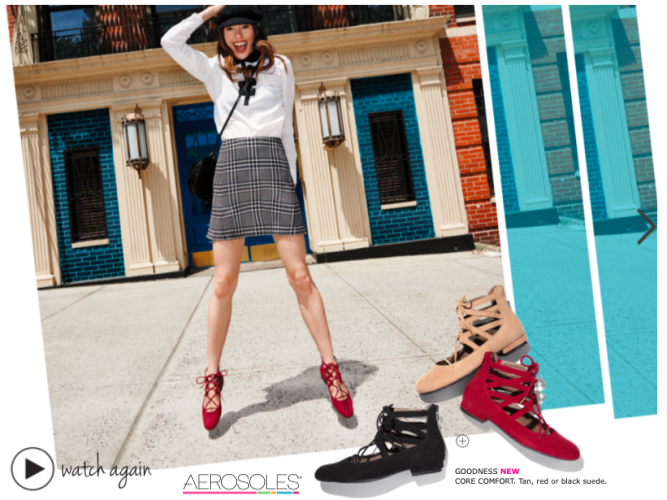 Source: Aerosoles
Source: Aerosoles
The retail store has had hundreds of years to perfect managing the customer relationship. By comparison, retailers are still discovering the depth and nuances to creating an online relationship with the customer. This digital relationship gap creates clear opportunities to get closer to consumers, differentiate from competitors and grow sales by creating a buying journey that puts content to work.
I recently had the pleasure of hosting a dinner in San Francisco with CMOs from some of the leading retail brands. The discussion focused on developing effective digital content strategies that help retailers stand out by fostering a more engaging and emotional relationship with their consumers. Three content areas stood out in the conversation — social, mobile and shoppable experiences, all of which have real hurdles for retailers.
Social Content for Commerce
Social commerce continues to gain momentum as a trend, particularly as an effective way to connect with millennials. Social networks are becoming the new online marketplaces. Facebook, Instagram, Twitter and Pinterest all have facilities for brands to sell directly to consumers. The logic is simple: Target consumers where they spend the majority of their time online — in social networks.
Consumers expect more shopping inspiration from a retailer’s social media content. One recent report by loyalty analytics company Aimia (which owns the Nectar loyalty brand in the UK) indicates that 56 percent of consumers who follow brands on social media sites say they do so to view new products and use the images that they see to inspire purchases.
In terms of content, this aspect of social media is essentially a brand-owned media channel, just like a website where content is controlled. But what about content that is generated elsewhere in social networks by third parties — enthusiastic vloggers, for example?
There are very real hurdles with unresolved questions. How can retailers incentivize third parties to review products and create content that links back to the retailer’s site so a customer can easily purchase? How can retailers manage and analyze it as a marketing process? And how can they leverage the content that is produced by independent third parties, especially unaffiliated social influencers? In this view, content is fragmented — a mix of user-generated, earned media and brand-generated, owned media. While some retailers successfully harness the power of third-party content, others — particularly larger businesses — may initially find it too much effort, with not enough reward.
Mobile Commerce
Perhaps the biggest change that retailers have seen is in how browsing behavior is increasingly characterized by shorter and shorter pockets of time. The advent of the smartphone means that focused consumer attention has become increasingly scarce. Compelling content is important to draw the customer in, inspire and connect them to the product. But the consumer must be hooked quickly as today’s shoppers rapidly snack on retail content from their smartphones.
Unsurprising then that retail traffic on mobile outweighs desktop traffic, but the reverse is true for actual sales conversions (many guests said that mobile traffic accounted for 66 percent of overall traffic to their website, but mobile conversion rates were significantly lower than desktop).
Retailers need to re-engineer their ecommerce sites to capture the attention of the fast-moving consumer equally on mobile as with desktop environments. On mobile, the experience certainly needs to be immersive and immediately transactional by employing rich creative content within the context of the mobile device. While most companies take a mobile-first strategy, very few are creating mobile-first content that includes creative, commerce and context, such as interactive lookbooks, guided selling tools, visual configurators and more for mobile.
As importantly, the mobile path to purchase is significantly different than the desktop path, and several dinner attendees admitted challenges in making their mobile path to purchase simple, efficient and accessible.
Lifestyle Content vs. Transactional Shoppable Content
Another hot topic for the evening was integrating lifestyle content that is designed to inspire and emotionally connect with the consumer and the practical need to convert visitors with a highly efficient path to purchase. An outerwear brand, for example, might spend a lot of budget on inspiring video or images of mountaineers wearing their garments while climbing an impossible overhang at 20,000 feet, yet struggle to make that same image easily shoppable.
The other end of the scale is the traditional utilitarian ordering of products according to simple logic that brings together site search, filters and an image grid of similar products. This uninspiring approach forces consumers to envision the possibilities of a product on their own, using little more than sterile product images and spec data points. Yet the grid is still widely used because the path to purchase is usually obvious and efficient.
As with mobile, when taking a content-centered approach, it’s absolutely vital to inspire consumers with great immersive content and to make that content easily shoppable to optimize conversions.
To create engaging digital experiences, retailers need to employ rich media, such as video and lifestyle imagery, enabled with “quick looks” so a consumer can purchase a product or entire set of products without leaving that page. Achieving this is what sets apart an online experience from just a nice set of images.
Previously for many retailers, the time and resources that it took to create shoppable content was prohibitive. Just a few iterations back and forth between a CMO and a web development team meant that the cycle could take weeks or months from ideation to development to publishing a campaign.
However, in recent years, ever more sophisticated techniques, enabled by new technology platforms, are helping to elevate the ecommerce experience, and savvy retailers are changing their approach as a result. These intuitive tools require no coding experience and help marketing teams to create campaigns with multiple interactive and shoppable elements in days or even hours rather than months. The result is creative freedom with marketers able to update experiences and drive sales with engaging, shoppable content.



